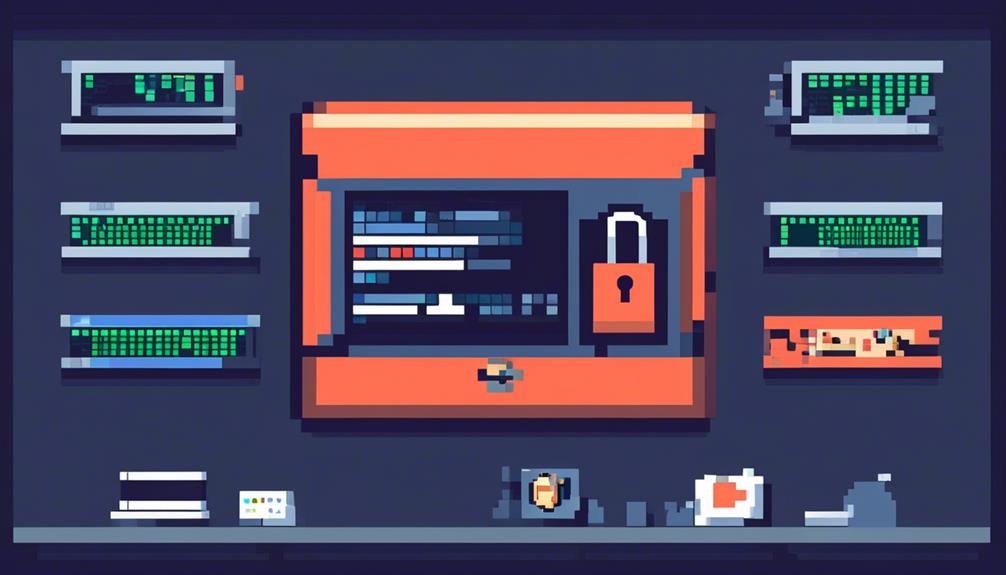In the world of business communication, PBX system configuration basics play a crucial role in ensuring seamless connectivity and efficient operations. From the initial installation process to the ongoing maintenance and scalability, a well-configured PBX system can provide businesses with a private communication network that meets their specific needs.
But what exactly are these configuration basics? How do you set up and configure a PBX system? What are the key components and considerations?
In this discussion, we will delve into the intricacies of PBX system configuration, exploring topics such as network configuration, user extension setup, call routing, voicemail and auto attendant setup, call forwarding, security settings, and more. By understanding these fundamental aspects, businesses can optimize their PBX systems and harness their full potential.
So, let's embark on this journey and unlock the secrets of PBX system configuration together.
Key Takeaways
- The PBX system components include the Key Service Unit (KSU), circuit cards, cords, reliable power source connection, and an indicator light monitoring system.
- Network configuration involves IP address assignment, static IP addresses, VLAN configuration, and separate VLANs for voice traffic to ensure consistent connectivity and quality of service.
- IP address assignment and VLAN configuration facilitate smooth communication within the phone system network, seamless call routing, and effective management of traffic and applications.
- User extension setup and call routing configuration involve determining the number of extensions needed, assigning unique extension numbers, configuring call features, testing connectivity, and providing training and support for users. It also includes routing options, destination settings, voicemail and auto attendant setup, call forwarding and call waiting configuration, and security and maintenance settings.
PBX System Components

PBX system components form the foundational hardware and circuitry necessary for the efficient operation of the Key Service Unit (KSU). The KSU serves as the core of the PBX system, providing the central control and management of incoming and outgoing calls. It is equipped with circuit cards that enable the implementation of voicemail functionality, allowing users to receive and store voice messages.
To connect telephone lines to the KSU, appropriate cords provided by the vendor are used. These cords ensure proper communication between the KSU and the external telephone network, facilitating seamless call routing and transfer. Additionally, the KSU requires a reliable power source connection to ensure uninterrupted operation. An indicator light monitoring system is also in place to provide real-time status updates and alerts, helping administrators identify and address any issues promptly.
Proper configuration and programming of the PBX system components are crucial for optimal performance. Vendors typically provide a programming guide that aids in setting up codes, training users, and troubleshooting minor issues. This guide serves as a valuable resource for administrators to ensure that the PBX system is tailored to the specific needs of the organization.
Network Configuration
When configuring the network for a PBX system, two important points to consider are:
- IP address assignment: Assigning static IP addresses to the PBX system and other network devices ensures consistent connectivity. This prevents any potential issues that may arise from IP address conflicts or dynamic IP address assignment. Static IP addresses also make it easier to troubleshoot and manage the network.
- VLAN configuration: VLAN configuration allows for the segmentation and prioritization of voice traffic. By creating separate VLANs for voice traffic, organizations can prioritize the transmission of voice data and ensure quality of service. This helps to prevent latency, jitter, and packet loss that can degrade the quality of voice communications.
IP Address Assignment
IP address assignment plays a critical role in configuring the network for PBX systems. Proper assignment of IP addresses ensures smooth communication within the phone system network.
There are two common methods for IP address assignment in PBX systems:
- DHCP (Dynamic Host Configuration Protocol): This protocol automatically assigns IP addresses to devices connected to the network, simplifying the configuration process. It dynamically allocates and manages IP addresses, ensuring efficient use of available addresses.
- Static IP address assignment: In this method, fixed IP addresses are manually assigned to devices. This provides stability and consistency, as devices always have the same IP address.
Regardless of the method used, proper IP address assignment is essential for the smooth operation and connectivity of a PBX system. It ensures effective communication within the telephone network, facilitating seamless call routing and other essential functionalities.
VLAN Configuration
To enhance network security and performance, VLAN configuration allows for the segmentation of a network into separate virtual LANs. By assigning devices to specific VLANs, network administrators can control traffic, prioritize applications, and enhance network efficiency. VLAN configuration involves assigning switch ports to specific VLANs, setting up VLAN trunks between switches, and configuring VLAN interfaces on routers. VLANs can be used to logically group devices based on department, function, or security requirements, enabling better network management and control. Implementing VLAN configuration requires careful planning and understanding of the network's layout and traffic patterns.
| VLAN Configuration | ||
|---|---|---|
| Assign devices to specific VLANs | Control traffic | Prioritize applications |
| Set up VLAN trunks between switches | Enhance network efficiency | Improve network performance |
| Configure VLAN interfaces on routers | Segment network | Enhance network security |
| Logically group devices based on department, function, or security requirements | Better network management | Improve network control |
| Requires careful planning and understanding of network layout and traffic patterns | Network segmentation | Efficient network operation |
User Extension Setup

User extension setup involves assigning unique extension numbers and voicemail access codes to individual users for personalized communication within the PBX system. This process is essential in enabling effective internal and external communication within an organization. Below are the key steps involved in setting up user extensions:
- Determine the number of user extensions needed: The size of the organization and communication requirements will determine the number of user extensions required. This step ensures that each user has their own dedicated extension for seamless communication.
- Assign unique extension numbers and voicemail access codes: Each user is assigned a unique extension number and voicemail access code to personalize their communication within the PBX system. This allows users to easily identify and reach each other within the organization.
- Configure call forwarding, call waiting, and other features: Based on the specific needs of each user, call forwarding, call waiting, and other features can be configured. This customization ensures that users have the necessary features and functionality to meet their communication requirements.
- Test each user extension: It is crucial to test each user extension to ensure seamless connectivity and proper functionality within the PBX system. This step helps identify any issues or discrepancies that may affect the user's ability to communicate effectively.
In addition to the setup process, providing training and support to users on how to utilize their extensions effectively is essential. This ensures that users are familiar with the features and functionalities available to them, enabling them to make the most of their extensions for both internal and external communication.
Call Routing Configuration
Call routing configuration involves determining the routing options and destination settings for incoming calls within a PBX system.
Routing options include determining how calls are prioritized and directed based on specific criteria such as business hours or caller type.
Destination settings involve setting up rules for call forwarding, call waiting, and call transfer to ensure efficient call handling and customization of call flow.
Routing Options
Routing Options (Call Routing Configuration) enables the setup of call routing rules to efficiently direct incoming calls based on predefined conditions, ensuring effective management of call flow within an organization. With the routing options available in a PBX system configuration, organizations can tailor their call routing to meet their specific needs.
Here are four key routing options to consider:
- Time-based routing: This option allows calls to be routed differently based on the time of day or day of the week. For example, calls can be directed to different extensions during business hours versus after-hours.
- Direct Inward Dialing (DID) routing: With DID routing, incoming calls can be directed to specific extensions or groups based on the dialed number. This helps streamline call handling and improve efficiency.
- Percentage-based routing: This option allows calls to be distributed among multiple extensions or groups based on specified percentages. It ensures equitable distribution of calls and prevents overloading of specific resources.
- Advanced call handling features: PBX systems offer features like call forwarding, simultaneous ringing, and sequential ringing. These features can be configured in the call routing rules to ensure calls are handled appropriately and efficiently.
Destination Settings
Destination settings in the call routing configuration determine the designated location for incoming calls within the PBX system. With call routing configuration, businesses can route calls based on specific criteria such as time of day, caller ID, or dialed number.
By configuring destination settings, calls can be directed to specific extensions, groups, voicemail boxes, or external numbers. This flexibility allows for efficient call handling and distribution within the PBX system.
Additionally, destination settings enable call forwarding to external numbers or mobile devices, providing further flexibility in call management. Businesses can effectively manage call routing and ensure calls are directed to the appropriate destination using these configuration settings.
The destination settings play a crucial role in the overall PBX system configuration, allowing businesses to optimize their call handling processes.
Voicemail and Auto Attendant Setup

To configure voicemail and set up an auto attendant, access the PBX system and define parameters such as greeting messages and notification preferences. The telephone system's voicemail feature allows callers to leave messages when users are unavailable, ensuring efficient call management.
Here are the steps involved in setting up voicemail and auto attendant:
- Assign extension numbers: Assign unique extension numbers to users to facilitate voicemail box configuration and call routing.
- Customize greeting messages: Create professional greeting messages that provide callers with instructions on how to leave a message or access menu options through the auto attendant.
- Configure voicemail boxes: Set up voicemail boxes for each user, specifying parameters such as maximum message duration, storage capacity, and password requirements.
- Set up auto attendant: Define menu options that callers can choose from to route their calls to the appropriate extensions or departments. This helps streamline call handling and enhances the caller experience.
When configuring voicemail and auto attendant settings, it is important to ensure that they align with the company's branding and reflect a professional image. Test the voicemail and auto attendant functions to verify that they are working as intended and make any necessary adjustments to optimize their performance.
Call Forwarding and Call Waiting Configuration
Effective management of incoming calls is essential for optimizing communication within the PBX system. Call forwarding and call waiting configuration are two important features that can enhance the efficiency of phone systems. With call forwarding, you can redirect incoming calls to another number when you are unavailable. This ensures that important calls are not missed and allows for seamless communication.
The table below outlines some common call forwarding options that can be configured within a PBX system:
| Call Forwarding Option | Description |
|---|---|
| Always | All incoming calls are immediately forwarded to the specified number. |
| No Answer | Calls are forwarded to the specified number when there is no response after a certain number of rings. |
| Busy | Calls are forwarded to the specified number when the line is busy. |
| Unavailable | Calls are forwarded to the specified number when the user is unavailable or offline. |
| Follow Me | Calls are forwarded to multiple numbers or devices in a specified sequence. |
Call waiting configuration, on the other hand, allows users to handle incoming calls while already on an active call. It notifies users of an incoming call and enables them to switch between calls. The settings for call waiting can be customized to suit individual preferences and requirements.
To configure call forwarding and call waiting options, users can access the settings through their PBX system or VoIP account. By understanding and properly configuring these features, businesses can ensure that incoming calls are efficiently managed and important communications are not missed.
Security and Maintenance Settings

To ensure the security and smooth operation of the PBX system, it is crucial to configure appropriate security and maintenance settings. Here are some key practices to consider:
- Enable firewall and encryption features: These features help protect the PBX system from unauthorized access by creating a barrier between the internal network and external threats. Encryption ensures that sensitive data transmitted over the telephone lines is secure.
- Regularly update software and firmware: Keeping the PBX system software and firmware up to date is essential for patching security vulnerabilities and ensuring optimal performance. It is recommended to regularly check for updates from the service provider and apply them promptly.
- Implement strong password policies: Use complex passwords for user accounts and system access to prevent unauthorized entry. Avoid using default passwords and consider implementing multi-factor authentication for added security.
- Regularly back up system configuration and call records: Backup the PBX system configuration and call records regularly to prevent data loss and ensure business continuity. Storing backups in a secure location, such as an off-site server, is recommended.
In addition to these settings, it is important to set up automatic alerts and notifications for system maintenance, security breaches, and abnormal call activities. This allows the support team to proactively address issues and take necessary actions to maintain the security and performance of the PBX system.
Frequently Asked Questions
How Do I Set up a PBX System?
To set up a PBX system, there are several steps you need to follow.
First, you should start by finding a reputable service provider that offers PBX systems. This is important because you want to ensure that you are getting a reliable and high-quality system.
Next, you need to choose an appropriate location for the Key Service Unit (KSU). This is the central hub of the PBX system, so it needs to be placed in a location that is easily accessible and secure.
Once you have chosen the location, you can then plug in the circuit cards for voicemail if your system has that capability.
After that, you need to connect the KSU to the telephone lines using the provided cords. This will allow the system to communicate with the outside phone lines.
It is also important to ensure that the KSU has a proper power connection. This is usually done by plugging it into a standard electrical outlet.
Once everything is connected, you can monitor the system using the indicator lights on the KSU. These lights will provide you with valuable information about the status of the system.
If you want to add VoIP capabilities to your PBX system, you may also consider adding an IP-PBX gateway. This will allow you to make and receive calls over the internet, which can be a cost-effective option.
If you encounter any issues during the setup process, you can troubleshoot them using PBX system troubleshooting techniques. These techniques will help you identify and resolve any problems that may arise.
In addition to the setup process, it is also important to consider the benefits of using a cloud-based PBX system. These systems offer scalability and cost-effectiveness, making them a popular choice for many businesses.
When choosing a PBX system for your business, you should consider factors such as the size of your business and the features that you need. This will help you find a system that meets your specific requirements.
What Are the Three Main Components of the Pbx?
The three main components of a PBX system are:
- The Key Service Unit (KSU): The KSU acts as the central hardware that connects all the phones and phone lines. It manages the routing of calls and controls the features and functions of the PBX system.
- Telephone lines: Telephone lines are the physical connections between the PBX system and the public telephone network. These lines enable inbound and outbound calls, allowing users to communicate with external parties.
- User stations: User stations, such as physical phones or extensions, are connected to the PBX system. These stations allow users to make and receive calls within the internal phone network. They are typically assigned unique extensions and can access various features and services provided by the PBX system.
With these three components working together, a PBX system enables efficient communication within an organization by providing centralized control over phone lines and user stations.
What Is PBX Phone System Basics?
A PBX phone system, also known as a private branch exchange, is a telephony solution that allows businesses to create their own private communication network. It offers features like video calls, conference calls, and more.
Implementing a PBX system in your office provides benefits such as improved communication, cost savings, and scalability. A PBX administrator plays a crucial role in managing the system, ensuring its smooth operation.
Different types of PBX systems are available in the market, each offering unique features and capabilities. However, configuring a PBX phone system can present challenges that need to be addressed.
How to Configure Analog PBX Telephone System?
Configuring an analog PBX telephone system involves troubleshooting common issues, understanding the benefits of analog systems, and exploring the process of upgrading to digital PBX.
Best practices for configuring PBX extensions should be followed to optimize functionality and ensure seamless communication.
Additionally, integrating the PBX system with VoIP technology enhances communication capabilities.
